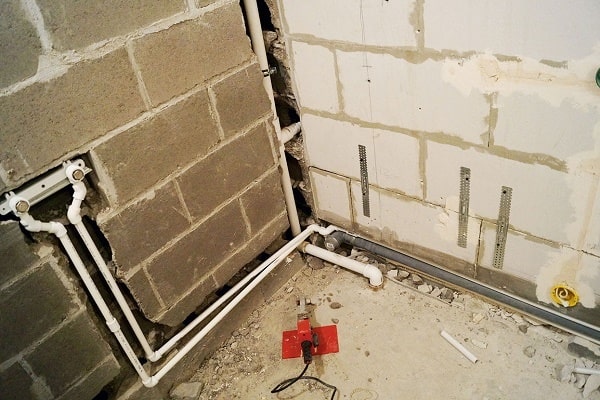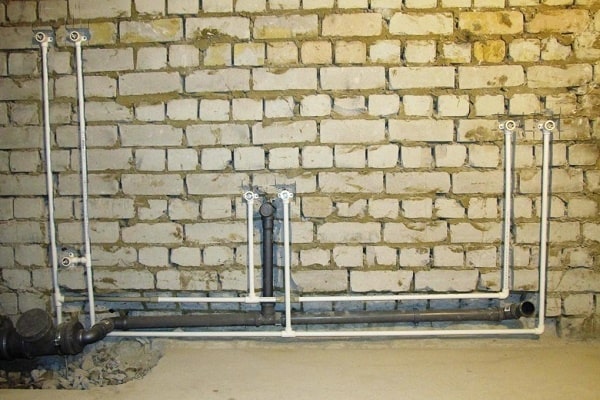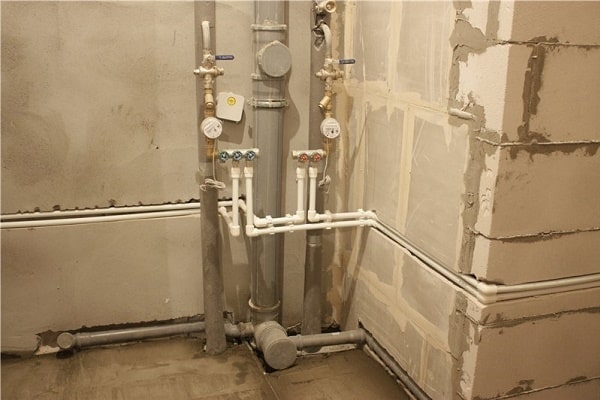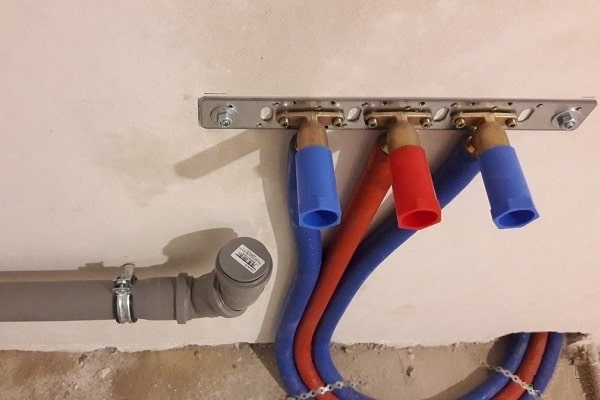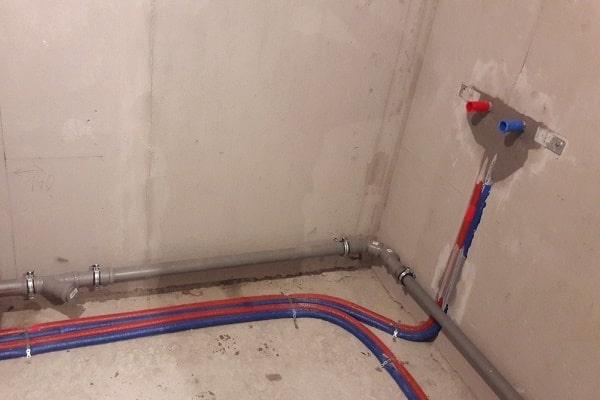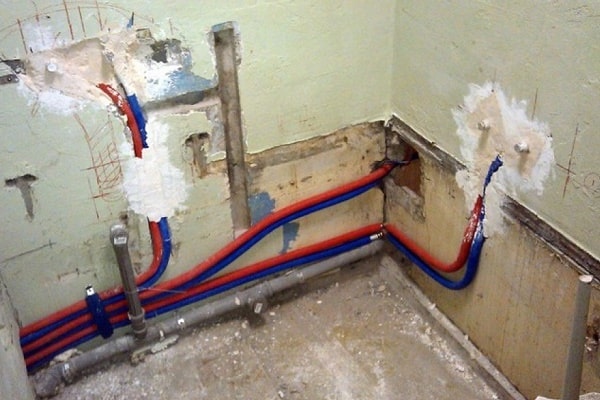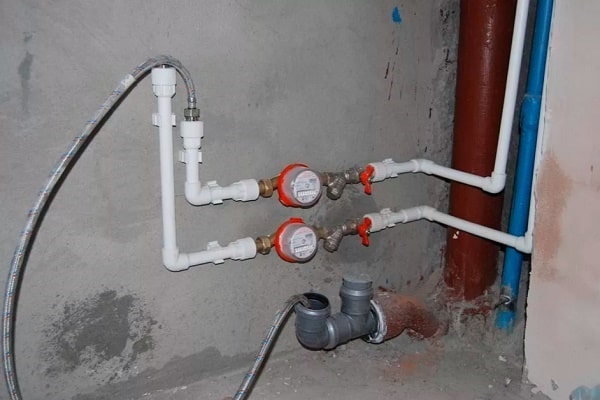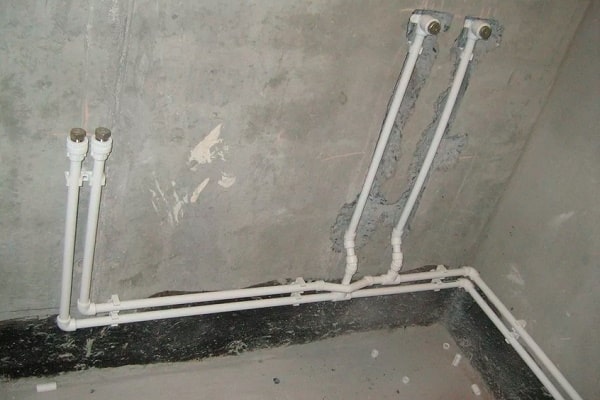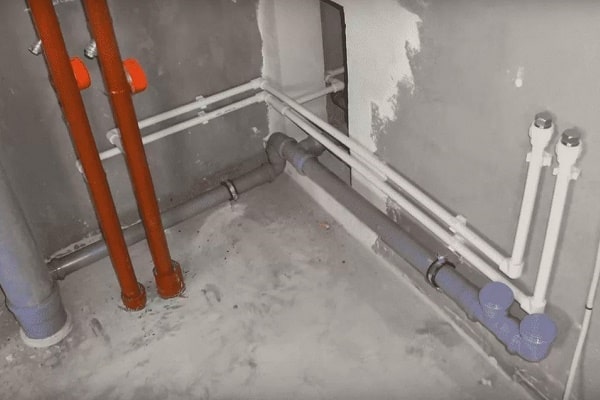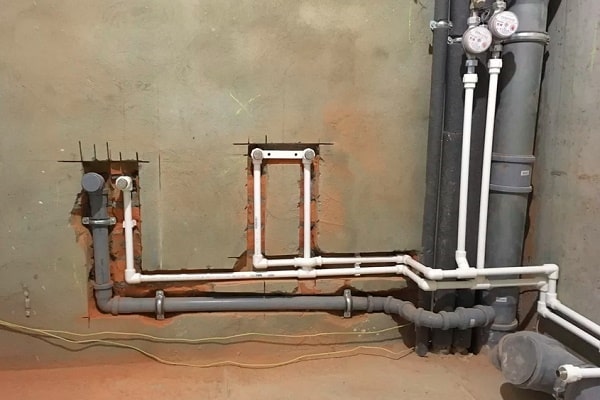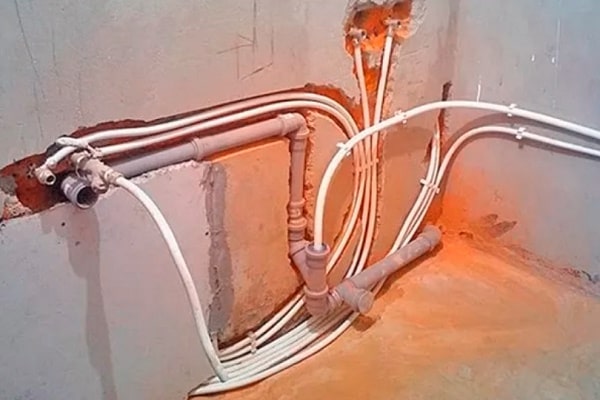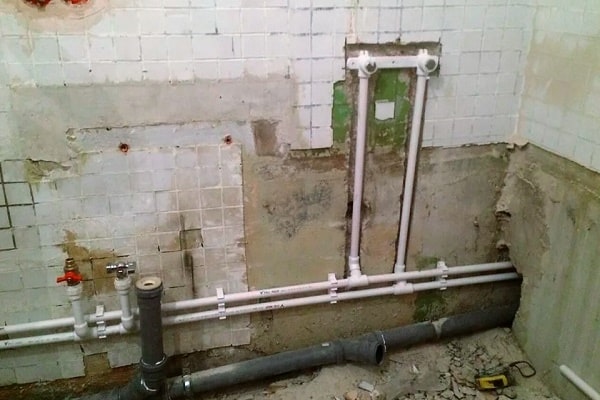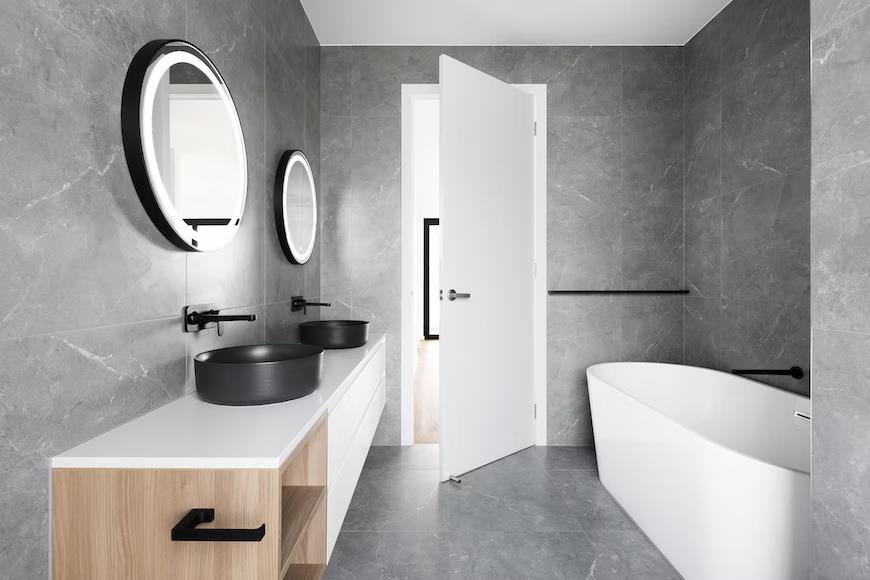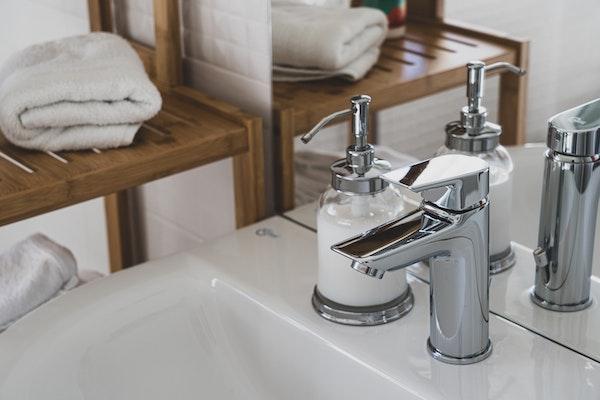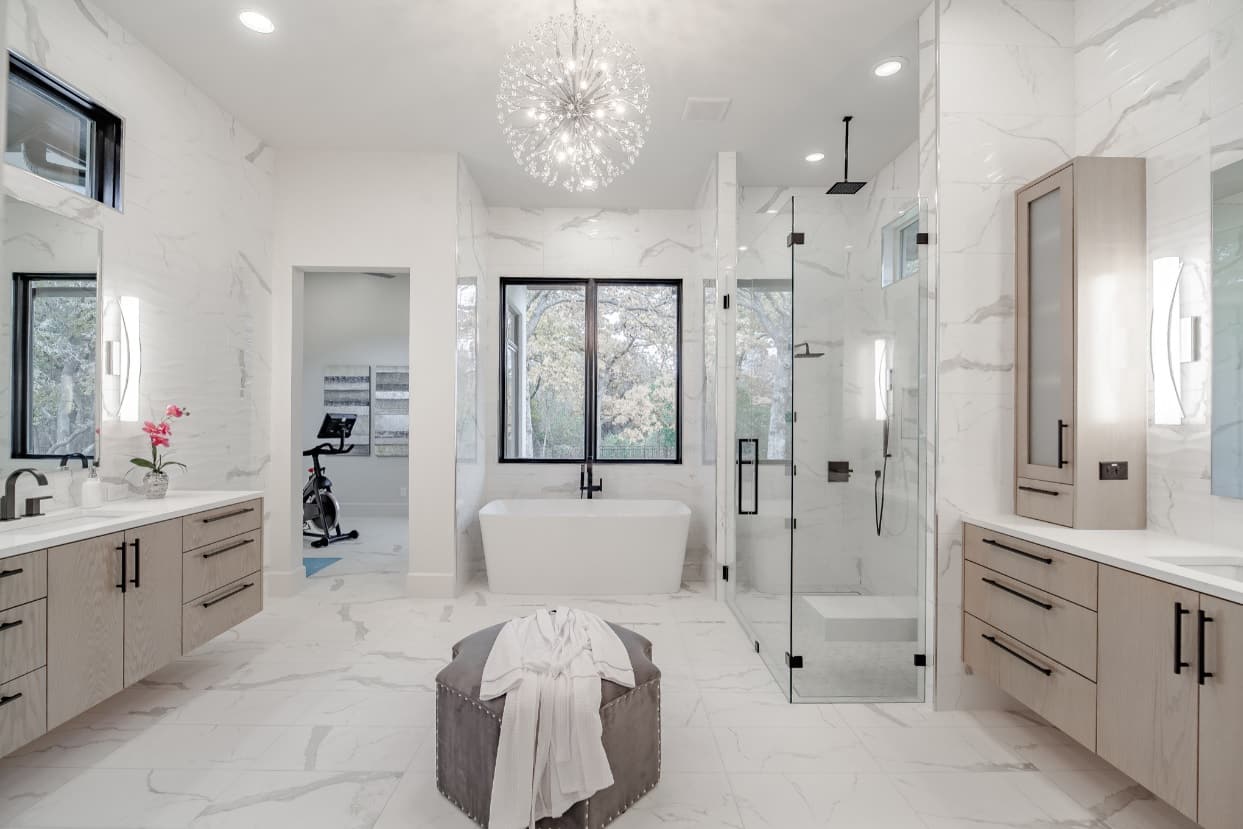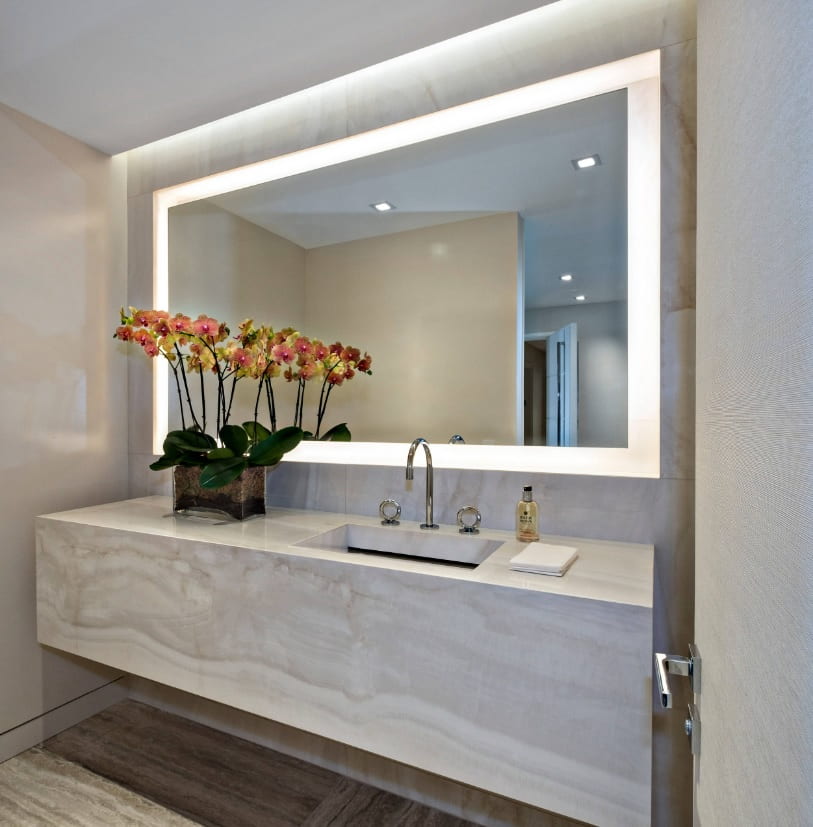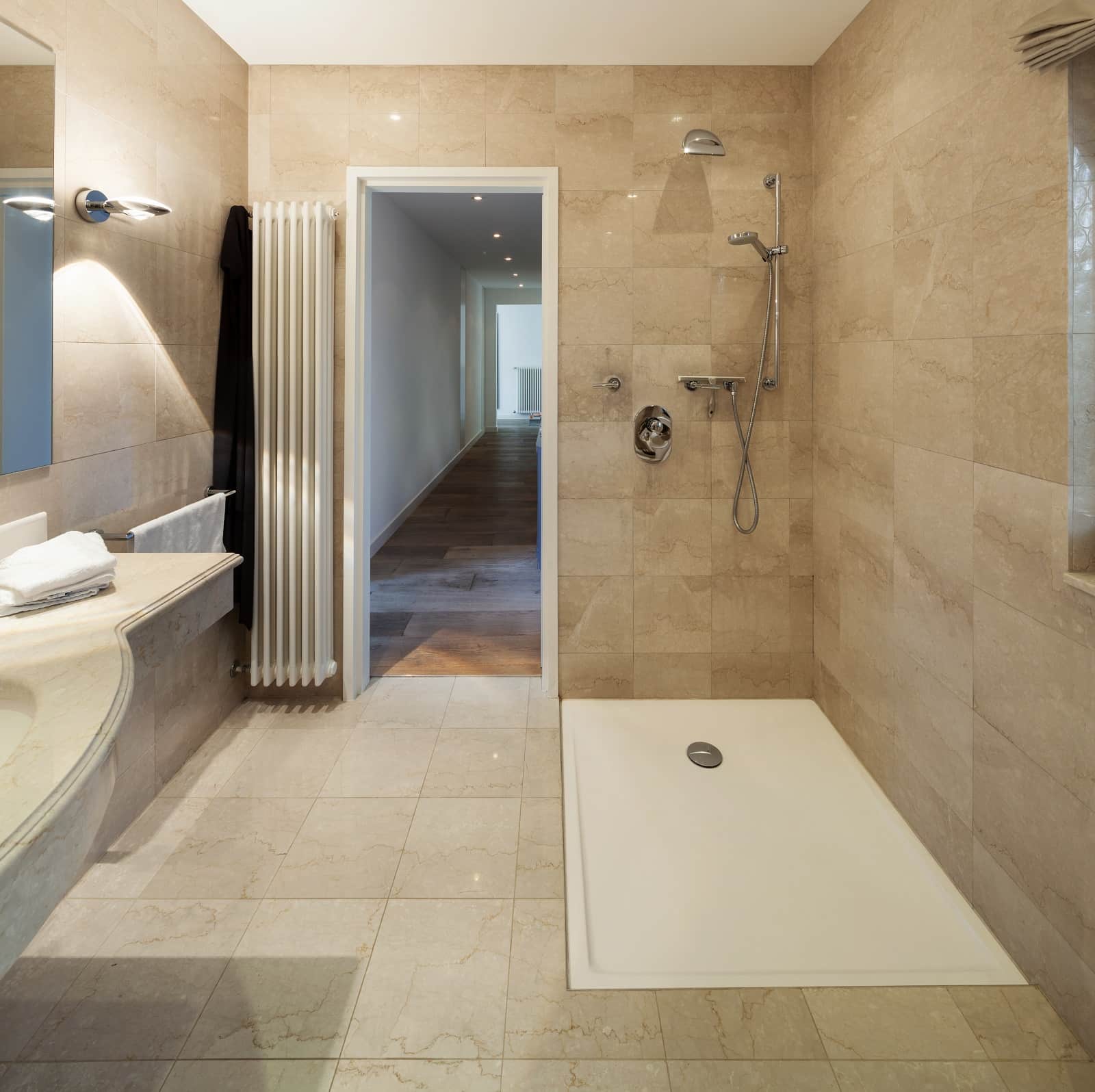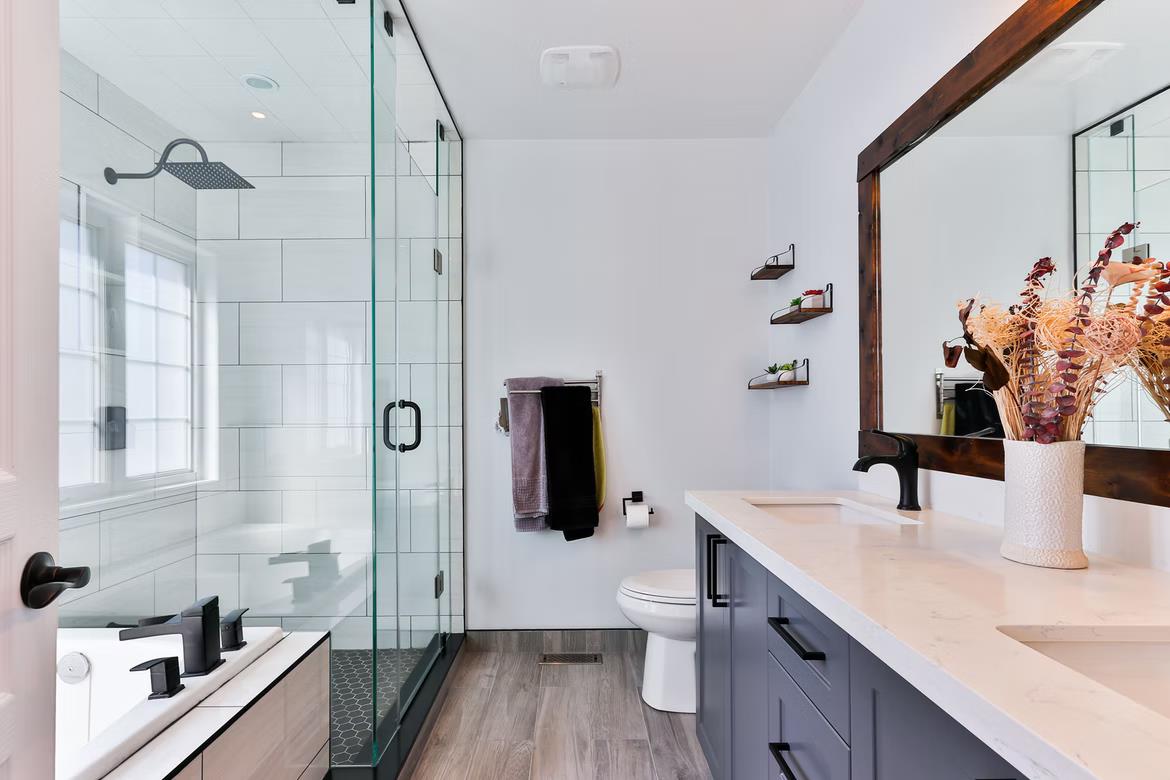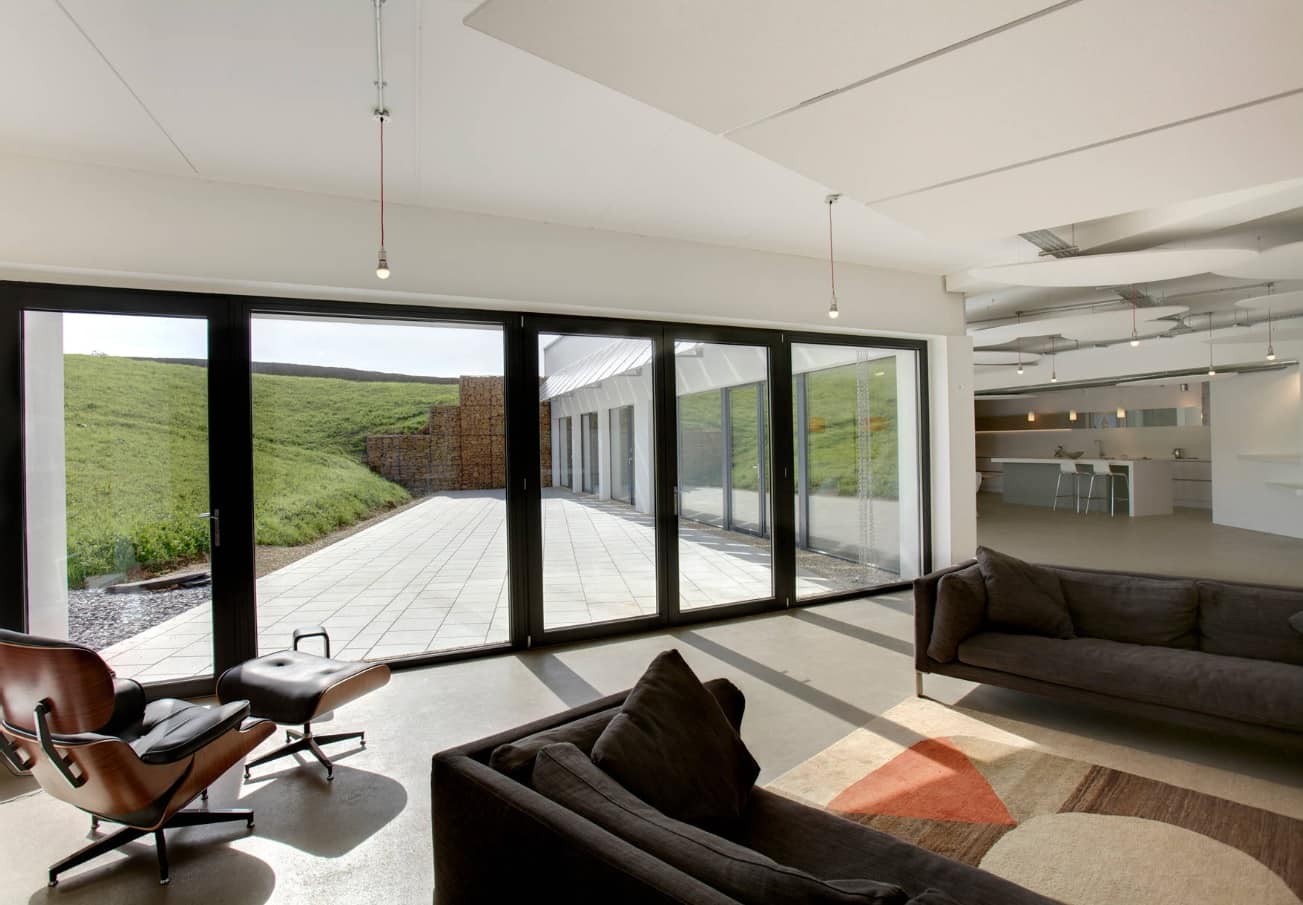Are you going to make a bathroom renovation with a complete replacement of water pipes? Plumbing in the bathroom usually takes a lot of time and money. You will agree, it would be a very unpleasant moment if soon after the repair one of the pipes leaks or a more serious breakdown occurs. To avoid this, you should not only have an idea but also know the basic principles of bathroom plumbing.
Many people, even novice home masters, are ready to perform plumbing work on their own. And this is quite real – pipe routing in the bathroom or even in the combined walk through shower can be done independently, as new technologies and materials greatly simplify the installation and maintenance of engineering systems.
This article will describe the principles of pipe routing in the bathroom. We will explain the differences between a hidden and an open installation system, and talk about how to independently equip plumbing. We will also add thematic photos and diagrams that will help you better understand the essence of the matter.
Content:
How to Start?
You should not take an example from those who prefer to do everything “by eye”. Begin with a project for future plumbing. This may seem redundant and even too complicated, but, nevertheless, such a project is necessary.
With it, you can accurately determine the optimal place for each plumbing fixture, select the necessary parts and elements of pipelines and determine their flow rate.
It is recommended to start the project from the list of plumbing equipment, which is planned to be placed in the bathroom. It is important to know that if the toilet and the bathroom are separated in the house, you need to carry out the plumbing project for both rooms. This is because their utilities are connected and cannot be mounted separately.
Having decided on the list of plumbing, you should mark which pipes you need to bring to each of the devices.
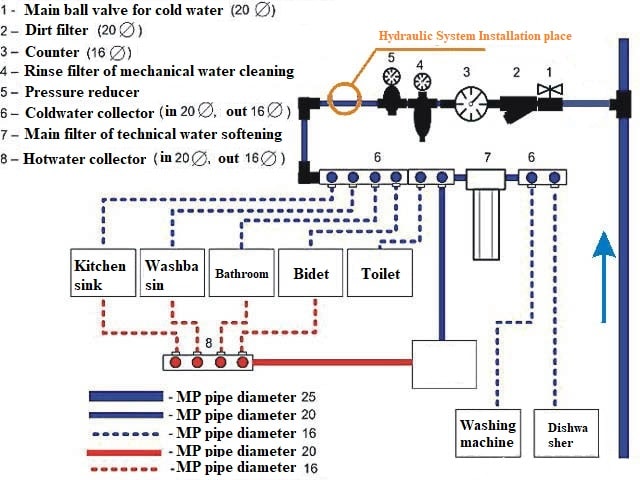
A competent project for bathroom plumbing necessarily takes into account the availability of plumbing fixtures, valves, meters and other elements of the system
You can focus on such a scheme:
- Bathtub of any type or shower cabin. Connects cold and hot water, as well as sewage.
- Washbasin or vanity. Sewerage, hot and cold water supply.
- It is connected to the pipeline of hot, cold water supply and to the sewerage.
- Coldwater and sewer should be connected.
- Washing machine. Sewerage and cold water supply.
At the next stage, you need to build a framework for a future project. For this, accurate measurements of the room are carried out, according to which the scheme is subsequently built. It is desirable to perform it on graph paper on a suitable scale.
All sizes must be strictly observed. This is an important condition for the implementation of a competent project. All plumbing fixtures are also measured in the same way. Their sizes are needed in order to “fit” the equipment into the room as accurately as possible.
If there is no final decision regarding the location of the plumbing yet, you can proceed as follows: precisely according to the measurements made, in accordance with the scale of the premises, a schematic image of each plumbing fixture is built on paper.
The pattern is cut out, and the resulting figures should be placed on the floor, achieving the optimal arrangement of devices.
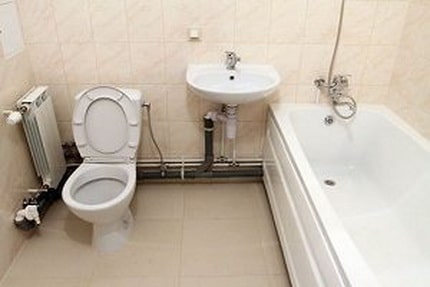
When carrying out the plumbing project, it is important to follow the recommended sequence of plumbing fixtures. So, the toilet should be as close as possible to the riser
In doing so, the following requirements must be taken into account. The first device placed at the sewer riser is the toilet. It is optimal for its outlet to be connected to the riser by means of a fitting. A large distance from the riser, and, moreover, the presence of turns in the pipeline will provoke blockages and will not allow the equipment to work normally.
Plumbing fixtures should preferably be positioned so that drains from them spilled through the toilet. This will be a very good prevention of blockages.
In addition to the toilet, it is recommended to place a bathtub or shower with a low drain closest to the sewer riser. This is to prevent possible bias problems. The rest of the plumbing equipment can be placed at any convenient distance.
In addition, it is advisable to carefully study the technical documentation of plumbing equipment for its connection. If a typical variant is presumed (which provides for a single-level arrangement of the pipeline with the axis of the sewer outlet of the device), no problems will occur.
If the atypical connection is supposed, it is necessary to be prepared for all its features.
Most often, variations in connection can be in the toilet. Depending on the model, their drain can be direct or inclined, as well as directed towards the floor or wall. The technology for installing a toilet with an oblique outlet has its own characteristics.
Atypical may be the connection between showers and bathtubs. Decoupling of their drain can have a different configuration. All these features must be taken into account at the design stage.
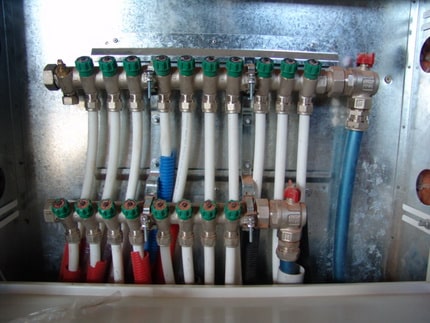
Pipe routing can be performed by various methods. It is important to get acquainted with the features of each type and be prepared to competently implement the selected option at the design stage
After the plumbing installation sites are fixed, work begins with the placement of pipelines suitable for them. The scale of the scheme must be strictly adhered to. Only in this way, it will be possible to carry out the correct installing of pipes in the bathroom.
An important nuance. When dealing with the “arrangement” of plumbing and furniture, one should not forget that all the doors in the room should open freely and it should be convenient to use each device.
Types of Utility Lines for Bathroom Plumbing
Before designing the plumbing, you should get acquainted with what varieties of such designs exist. There are only three of them. And one, with bushings, is practically not used. Therefore, we will not consider it.
Type # 1. Serial Plumbing
For its implementation from the risers of cold and hot water supply, bends are made leading to the first consumer item. Pipes are leading from it to the second one and so on. Each water intake point is equipped with a tee, to one of the outlets of which a consumer is connected.
In general, this is a very simple scheme. Nevertheless, it can only be used where the number of water consumers is small.
This is due to the fact that with the simultaneous activation of several water points at once, the pressure will weaken and may be insufficient for the correct operation of the equipment. This is the main disadvantage of serial plumbing.
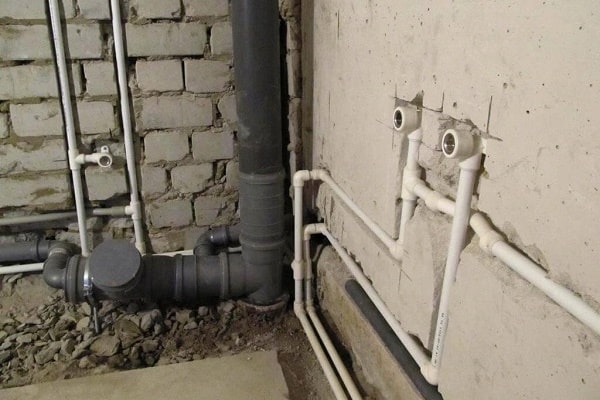
Sequential water distribution is also called a tee because it is assembled using tees. In this scheme, the devices are connected in series, which is most often accompanied by a pressure loss in the mixer far from the riser
However, for apartments with one bathroom and a small amount of plumbing used, this option may be the best. A significant drawback of the system is the inability to turn off one of the plumbing fixtures for replacement or repair.
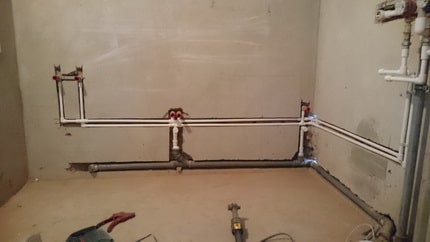
Serial plumbing is extremely easy to implement, but not very convenient to operate. However, for small bathrooms, this solution may be quite acceptable.
The advantages of serial plumbing are a bunch. First of all, it is simplicity in design and installation. There will be no complicated schemes, everything is very simple.
In addition, such plumbing is considered the most economical option. The consumption of pipes and other elements will be significantly lower than in other systems. Respectively, installation costs are also minimal.
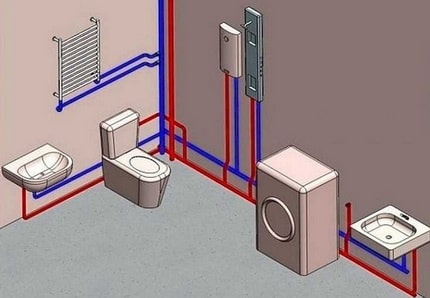
Even a novice plumber will cope with the design and subsequent arrangement of a consistent, otherwise, tee plumbing
Type # 2. Collector Type Plumbing
The collector scheme involves connecting each of the consumers to the main trunk. To do this, use a special element called a collector – a device that distributes water flows.
In a more complex version (and this is best one) each collector branch is equipped with a shut-off valve. Collector-type plumbing can be considered the most convenient option to use. There are several reasons for this.
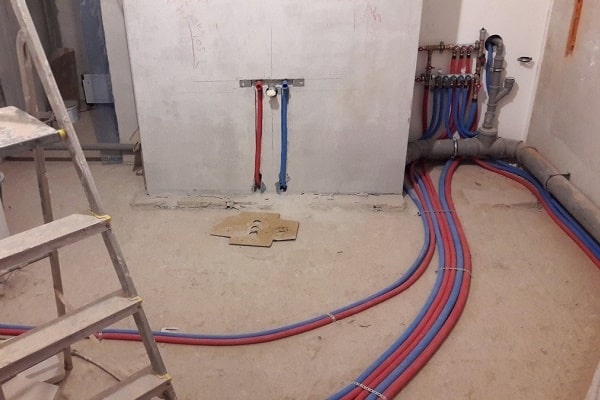
In the collector water supply system, all devices are connected to a distributor (collector). This allows supplying water to the devices within the riser with a pressure equal in all points
Firstly, the absence of pressure drops in the system. All consumers receive an equally good pressure of water, even if all points of drawdown operate simultaneously.
If the pressure in the system of an apartment or private house is too low for some reason, you can temporarily limit the supply of water to one of the consumers, for example, to the toilet, thereby increasing the pressure on others.
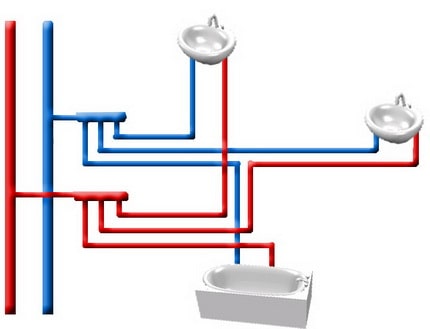
The collector type of plumbing is more convenient to use than the serial one. In this case, a separate trunk goes to each consumer, which ensures that there are no problems with pressure. However, the design and installation of such a system is more complex
Secondly, the ability to disconnect plumbing fixtures from the water supply if they need to be replaced or repaired.
Thirdly, – reliability. In fact, a single pipe goes to each consumer without any connections and other elements. The leak may occur only in the area of the collector or near the device itself. Therefore, it will be very easy to find. For this reason, pipes with collector plumbing can be safely installed using the hidden method.
Fourth, ease of use. If there is a problem with the plumbing fixture and there is a leak, for example, at the tap, you do not need to climb under the sink. It is enough to shut off the shut-off valve on the manifold leading to the malfunctioning device and wait for the arrival of specialists.
Even a woman or a child unfamiliar with plumbing intricacies can do this. In this case, all other equipment will work properly.
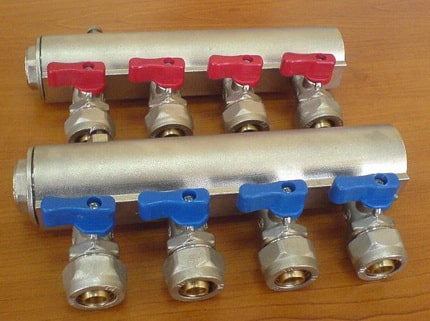
Professionals recommend using manifolds with shut-off taps for installation in water systems. With their help, if necessary, you can easily stop the flow of water to a branch or plumbing device that needs repair
However, collector plumbing has some disadvantages. First of all, it will cost the owner more than a sequential scheme. This is due to the fact that it will be necessary to lay a branch for each consumer. This will take a lot more material.
In addition, the installation of manifolds and shut-off valves (if the valves are not equipped with them) will be required. And the scheme itself will be much more complicated than a sequential one.
Installation Methods for Water Pipes
To install the bathroom plumbing, you can choose one of two options: hidden and open. We will analyze the latter in more detail.
Method # 1. Exposed Pipes
Open installation assumes that pipes and other elements of utilities are mounted directly on the wall or above the floor. This extremely facilitates and reduces the cost of their installation. But the general appearance of the bathroom suffers from this.
The advantages of open installation include:
- the possibility of continuous monitoring of the state of utilities – the pipes are always in sight and the appearance of a leak will not go unnoticed;
- ease of installation – the parts are connected and fixed in place. Even a novice plumber can cope with the work, given the method of connecting the elements of course.
- availability – the installation cost is minimal.
The disadvantages include the possibility of mechanical damage to open pipes. But this is rather true for plastic parts. It is not so easy to damage steel pipes.
In addition, utility lines are publicly available, which, of course, is an ugly looking thing. This drawback can be fought. When carrying out the bathroom plumbing project, you need to try choosing a place for laying pipes so that they are as invisible as possible.
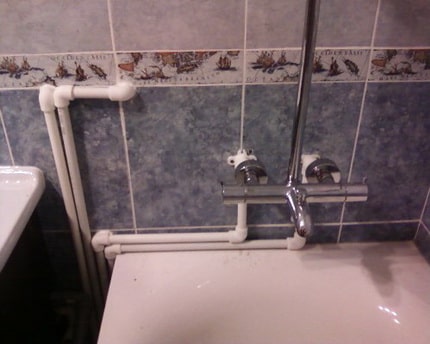
The method of open pipe laying is as simple as possible to implement. The result is a functional but less aesthetic pipeline. Therefore, they try to make it as inconspicuous as possible
It is clear that in this way they cannot be completely masked. Therefore, home craftsmen use all kinds of designs to hide unaesthetic pipes. The easiest way is to hide them in a box.
Most often, it is made of plastic panels or plasterboard. The latter must necessarily be moisture resistant, given that it will be used in the bathroom.
If space allows, it is quite possible to use false walls, behind which pipes are laid. A good option is the roller shutters. They look especially good behind the toilet.

All types of pipes are suitable for open plumbing devices, but copper, brass or steel water pipes with internal galvanization are preferred
Choosing the option of masking communications, you need to understand that aesthetics should not interfere with functionality, so all masking structures must be equipped with hatches through which inspection and necessary repair of pipes could be carried out.
In addition, it is not recommended to mask some pipes. These are, for example, steel parts. They are susceptible to corrosion which develops especially rapidly in conditions of high humidity. Therefore, they are best used only in open form.
The maximum is to hide them with an easily removable box and conduct regular inspections for external corrosion, which you must immediately begin to solve.
Method # 2. Concealed Engineering Communications
Pipe routing in a concealed bathroom plumbing method involves the installation of parts inside specially designed or newly made voids in building structures. It can be small niches or gouges hollowed out in the walls, whose dimensions slightly exceed the diameter of the laid pipes.
A hidden laying also includes laying the pipeline in a screed, when a layer of concrete mortar is mounted on top of the parts.
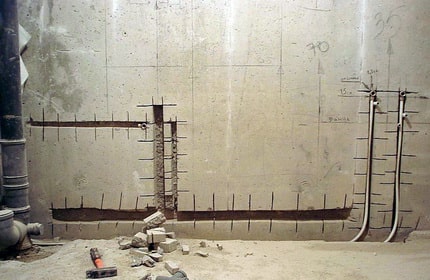
Sawing or cutting strobes under pipes is a very time-consuming operation. Before doing them, you should draw lines on the wall where the strobes should go, and calculate the exact dimensions of the cavities to fit the pipes
The undoubted advantage of this option is considered aesthetics. Utilities are completely invisible. Outlets of pipelines in the form of sewer sockets or water sockets are placed on the walls or on the floor. Accidental damage to pipes is not possible.
Significant disadvantages of this method of bathroom plumbing include:
- labor input;
- cost;
- lack of ability to control the condition of the pipeline.
Let’s review the hidden installation in more detail. First of all, it is not always possible. Cutting or hollowing out gates in the walls is allowed in private houses built from solid blocks or bricks, as well as in free-standing apartments.
In the latter, walls of increased thickness are made. In all other cases, conflicts with building codes are possible.
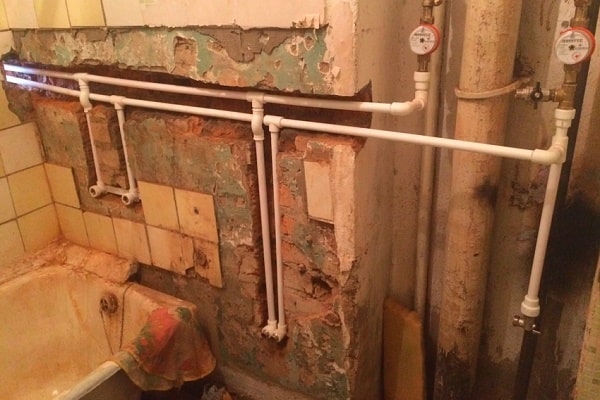
For the device of hidden laid water systems, polymer pipes are often used now. Their resistance to external influences ensures trouble-free operation for at least 50 years
Bearing structures are under significant load. Their strobes significantly weaken. For walls of increased thickness this is permissible. For standard walls, which are most often used in standard buildings, the answer is “no”.
Strobing in floor slabs is strictly forbidden for all types of buildings. As an alternative to gates, a pipeline can be laid behind the wall sheathing, in the screed or in the overhead space, if necessary.
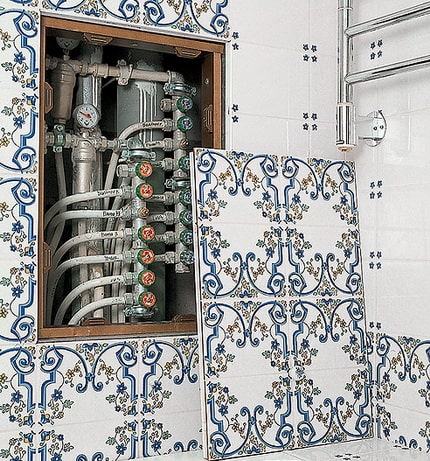
Performing a hidden installation of pipes, it is imperative to provide for the possibility of free access to the collector and counters, as well as to arrange inspection hatches if possible
Difficulties can arise with the sewer pipe if it needs to be masked under the floor. This happens when, for example, you need to bring communications to the bath-island, standing in the middle of the room or at a considerable distance from the wall. Sewer pipes have a large diameter, so you can not put them in the screed.
In this case, it will turn out to be too high and heavy, which will lead to an overload on the floors, and it may simply not withstand it. The best solution is to build a small podium, under which there will be enough space for utilities. The design can be frame or block.
Regardless of the location of the hidden pipeline laying and its purpose, the method of mounting parts does not change. All elements of the line fit into a special casing pipe. The latter is placed in the prepared technological cavity.
After the pipeline is laid, the cavities are closed up, the plane of the base is leveled. If necessary, the topcoat is laid.
The main disadvantage of hidden mounting is the inability to control the condition of the pipeline. For this reason, all its elements must be as resistant to corrosion as possible and reliably connected. Proper installation is very important.
The best option for hidden installation is plastic, copper and metal-plastic pipes.
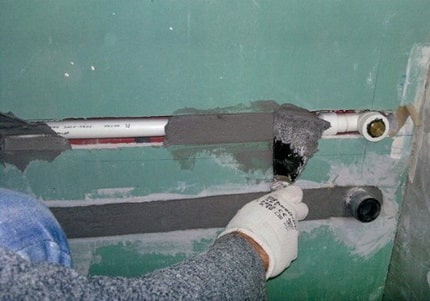
After laying the system into the prepared cavity, the gates are carefully sealed with a solution. The plane is maximally leveled and prepared for the subsequent finishing
Another important point that must be taken into account when applying hidden pipe mounting is to prevent possible condensation. If this happens, moisture will appear inside the structure, which sooner or later will provoke its destruction.
Therefore, it is recommended to place a pipe with hot water over the cold. In addition, both parts should be wrapped in a heat-insulating material, for example, a Merilon or the like.
Features of Utility Entry Point into the Apartment
Having decided on the type of piping in the toilet and in the bathroom, we finish the preparation of the project. For the system to work flawlessly, it is important that the input of utilities into the apartment is done correctly. Let’s figure out how to do it right.
First of all, there must be a stopcock at the inlet, which will make it possible to shut off the water supply if necessary. If the stop valves are already installed, it is necessary to check their quality.
Architects usually put nodes of good quality in new buildings. Outdated devices may be in old houses. It is advisable to put on the input ball valve type of good quality.
An important point. If you need to close/open the device, you need to do this smoothly. A sharp turn of the handle can provoke a water hammer, which is able to disable bathroom plumbing equipment.
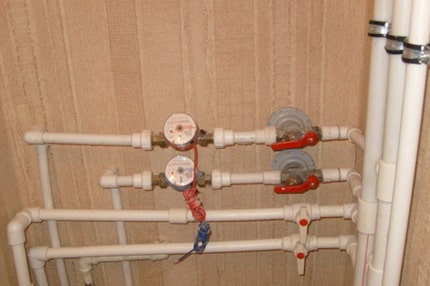
Shutoff ball valves, coarse filters, and counters are mandatory elements at the entrance of the water supply to the apartment. Pressure control equipment, fine filters, and other devices are installed by desire
Right after the ball valve, it is recommended to install a special leakage protection system equipped with a controlled shut-off valve. After it, a self-washing main filter is mounted. It will remove coarse impurities from the water, which significantly extends the life of the devices.
Place water counters, if necessary.
Next, you can mount the water flow regulator. This is not an obligatory element – it is necessary only where there are problems with the pressure of water. Next, a sequential or collector plumbing of an open or hidden type of installation is performed.

